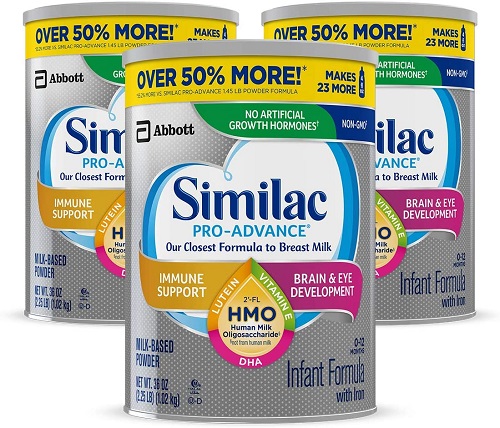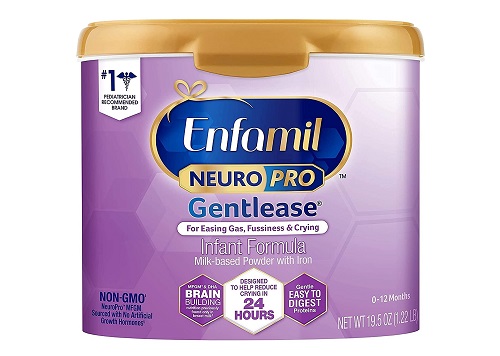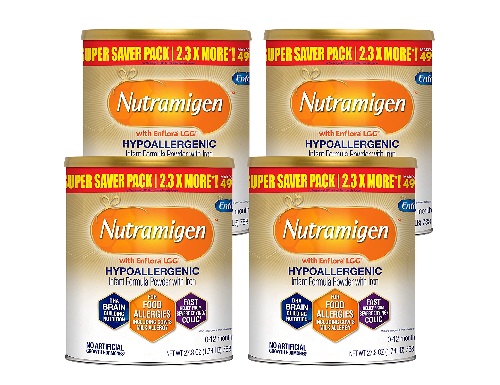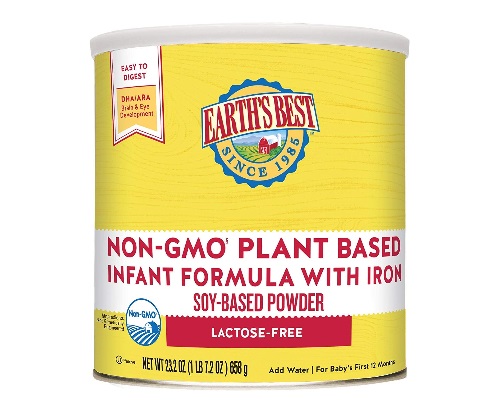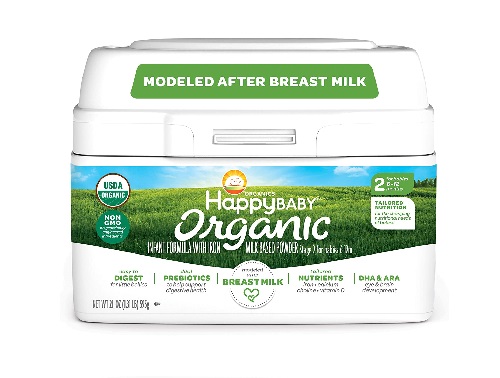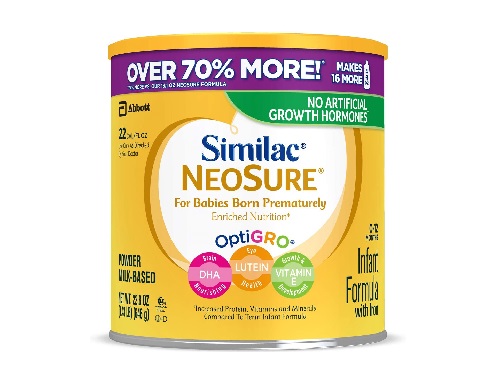Feeding your baby a balanced nutritious diet keeps them healthy and enhances overall growth and cognitive development. Infant formula is designed as complete nutrition for newborns up to one year. Many pediatricians admit that formula feeding is beneficial for up to one year, but it is no longer necessary after 18 months.
How long the formula is safe to consume for can be determined by the nature of the formula, its preparation, and storage specifications. It is essential to read the details on the baby formula container to learn how to prepare and store it correctly.
Top 4 Best Baby Formula – Comparison
What is Baby Formula?
Baby formula is a breast milk substitute. It is a manufactured food specifically for babies below 12 months. As some mothers are unable to breastfeed naturally or prefer not to do so, baby formula serves as a nutritious alternative with all the necessary components for child health and development.
Forms of Infant Formula
Baby formula comes in three forms: liquid concentrate, ready-to-feed, and powdered formula.
Ready-to-Feed Formula
The ready-to-feed formula is the most convenient and most expensive form of baby formula. It is formulated for direct feeding without additional ingredients or preparation. This type of formula is great for busy parents.
To use the formula, pour one feed amount into each sterilized bottle.Close the unused bottles tightly and store them in the refrigerator at 4 degrees or lower. Do not freeze the formula as it could alter the fat composition.
How Long is Ready-to-Feed Formula Good For?
Once you buy a ready-to-feed formula, check its use-by date on the container and use it before it’s due. The unopened formula is sterile; you can keep it at room temperature up to the date indicated by its manufacturer. After opening, close the container tight to avoid bacterial contamination, then refrigerate at four degrees and use within 48 hours. After feeding, throw away the leftover formula.
Concentrate Formula
Concentrate (or liquid) formula is a moderately priced formula that requires dilution with an equal amount of water. For example, you can mix the whole 13 oz can with 13 oz of water or mix enough for one feeding each time you need it.
How long is Liquid Concentrate Good For?
Before buying a liquid concentrate, check its manufacturer’s use-by date on the container; you should never use it after the given date. You can store unopened formula in a cool, dry place. The unopened liquid formula is sterile until opened, but you can refrigerate it after opening as long as you use it within 48 hours. You can also keep mixed but unused formula bottles in the fridge and safely use them in 48 hours.
Powdered Formula
The powdered formula is the cheapest of the three forms of baby formula. Most powdered formulas need to be mixed at a ratio of two parts water to one part powder formula. However, it is advisable to read instructions on formula containers since some require to be mixed at varying ratios.
When preparing your baby’s formula, measure the water first, add the powder formula, and mix it into a uniform solution. Once prepared, you can feed your baby immediately or within one hour. Unused but prepared formula should be refrigerated within 1 hour and used within one day after storage.
You should throw away your baby’s leftover formula and prepared formula that has been under room temperature for over one hour. Storing formula preparations in the refrigerator prevents them from bacteria infestation.
How Long is Powdered Formula Good For?
Check the expiry date of the powder formula on its can before buying. You should use the formula within one month of opening, keeping the container tightly covered in a dry place at room temperature. The mixed formula has to be refrigerated or used within one hour to prevent the growth of harmful bacteria. You can then use the refrigerated formula in 24 hours.
You’ll need to throw away the leftover formula 1 hour after mixing. To avoid wastage, prepare and put the formula in bottles each for one feeding.
Preparing Baby Formula
Preparing Ready-to-Feed Infant Formula
Collect all the items you need, such as bottles, a measuring cup, nipples, can opener, rims, and nipple and bottle brushes. Ensure to wash your hands meticulously with soap and water for at least fifteen seconds, then rinse and pat them dry. Clean and sanitize your working table and wash the items for use.
Sterilize your formula preparation items by boiling them in hot water for at least two minutes. Remove and place them on a clean paper towel using sterile tongs. Ensure the formula can is in good condition, clean and without dents. Next, clean the can’s top with very hot water and shake it well before opening it with a sterile can opener.
Pour one feeding amount in each of your baby’s bottles, cover unneeded bottles, and refrigerate them at 4 degrees. Use the bottles before 48 hours and never freeze the formula. Put a nipple, a rim, and cap over the bottle you need and feed your baby; be sure to throw away any leftovers.
You can feed your baby with cold formula or warm it first. To warm it, place the bottle containing formula in a bowl of hot water for less than fifteen minutes. Swirl the bottle for even warming. Pour a few drops of the formula at the back of your hand or wrist to test its temperature.
Preparing Powdered Formula
Start by washing your hands properly with soap and water and dry them. Boil water and let it cool for a maximum of 30 minutes. Wash your baby’s bottle and other items you may need in the process. Sterilize them in boiling water or a microwave steamer and allow them to cool.
Measure the cool boiled water into a container and add the required scoops of powder formula (follow the mixing ratio given by the manufacturer). Cover the container and shake for the water and formula to mix uniformly. Test the temperature by placing a few drops at the back of your palm or wrist. You can prepare for one or more feedings.
You can place the container with formula in a bowl of cold water to cool down to the right temperature. Divide the formula into one feed amounts per bottle. Use one bottle to feed your baby and store the rest in the fridge within an hour of preparing. Leftovers should be thrown away and stored bottles used in 24 hours.
Preparing Concentrate Formula
Begin by washing your hands thoroughly with soap and water and drying them. Wash and sterilize bottles and other items. Measure boiled and cooled water into a container and add the liquid formula specified by the manufacturer. Swirl to get a uniform mixture and test the temperature.
If you prepared for more than one feed, divide the mixed formula into one-feed bottles first. Then, feed your baby with one and store the rest in a fridge at four degrees. Use prepared formula within two hours and stored formula within 48 hours.
Types of Baby Formula
Cow Milk Protein-Based Formula
Unless you have had different advice from your pediatrician, treated cow’s milk is a good choice for your baby, since it’s palatable and nutritious. This type of formula is appropriate for most babies apart from those allergic to milk protein. It is often the first formula that parents offer their infants to drink, and use until weaning (one year). Examples include Similac Pro-Advance, Enfamil infant formula, and Happy Baby Organics infant formula.
Similac Pro-Advance Non-GMO Infant Formula
Similac Pro-Advance formula contains 2′ FL HMO, making it closer to breast milk. The 2′ FL HMO prebiotic strengthens your baby’s immune system to avoid frequent illnesses. The formula does not contain artificial growth hormones or genetically engineered ingredients.
The Pro-Advance formula contains a blend of Lutein, Vitamin E, and DHA –essential nutrients found in breast milk for brain and eye development. Additionally, Similac formula is a trusted brand by US parents and is widely used in hospitals.
Hydrolyzed Protein Formulas
Partially Hydrolyzed Protein Formulas
These contain milk protein that has been partially broken down into small pieces. This makes them easier to digest and less likely to trigger intolerance and allergies. Examples include Enfamil NeuroPro Gentlease, Similac Pro-Total Comfort, and Gerber Good Start GentlePro.
Enfamil NeuroPro Gentlease Baby Formula
Enfamil Gentlease is a scientifically formulated baby formula powder that eases fussiness, crying, spit-up, and gas within 24 hours. It contains MFGM and DHA, which are naturally present in breast milk, to enhance brain building.
The formula has complete nutrition for your baby’s first twelve months of life. It consists of dual prebiotics to boost immunity and easy-to-digest proteins suitable for sensitive tummies. The formula does not contain colors, sweeteners, flavors, or GMO ingredients.
Extensively Hydrolyzed Protein Formulas
These contain proteins that have been completely broken down into fine particles. They are lactose-free and suitable for babies with cow’s milk allergy or protein-induced abdominal issues. Examples include Enfamil Nutramigen, Gerber Good Start Extensive HA, and Similac Alimentum.
Enfamil Nutramigen Infant Formula
Enfamil Nutramigen relieves colic caused by cow’s milk allergy within 48 hours to make your baby happier. The formula contains LCG, a protein responsible for allergy management and supporting your baby’s digestive health.
The gentle, lactose-free Nutramigen formula contains ARA, Choline, and Omega-3 DHA for brain support. The formula supports your baby’s immune system to transition back to regular milk protein formula without allergies.
Soy-Based Formulas
Soy-based formulas contain soy protein. They are lactose-free, thus suitable for a baby who is allergic to cow’s milk. They can also be helpful for rare metabolic disorders like galactosemia.
You can use soy-based formulas if you’re a vegetarian or don’t want to include animal proteins in your baby’s diet. Examples include Earth’s Best Soy-based infant formula, Enfamil ProSobee, and Similac Soy Isomil.
Earth’s Best Soy-Based Powder Infant Formula
Eath’s best soy-based formula is complete nutrition for your baby’s first twelve months; it contains easy-to-digest high-quality proteins, vitamins, carbohydrates, essential fatty acids (DHA and ARA), and minerals. The lactose-free formula does not contain GMO ingredients.
The formula excludes artificial flavors, preservatives, colors, and synthetic herbicides/pesticides. It is suitable for milk protein intolerant babies.
Organic Baby Formulas
Organic baby formulas are produced without growth hormones, pesticides, herbicides, or antibiotics. They could be milk-based, and some may contain sweeteners such as sucrose. Examples include Happy Baby Organics, Earth’s Best Organic Dairy, and Similac Organic.
Happy Baby Organics Infant Formula
Happy Baby Organic formula is modeled after breast milk with organic lactose, essential vitamins, and minerals. It has four times more prebiotics than other organic formulas to boost your infant’s digestive health. The formula is corn syrup-free but contains DHA and ARA for eye and brain development. It is friendly on young tummies, keeping your little one happy.
Specialized Formulas
Specialized formulas are manufactured for premature newborns and infants with specific medical conditions. Examples are Similac NeoSure and Enfamil Reguline.
Similac NeoSure Infant Formula
Similac NeoSure is a nutrient-enriched formula for premature infants that enhances excellent catch-up growth. The milk-based formula is easy-to-digest with more proteins, vitamins, minerals, and energy than standard baby formula. It also contains DHA, ARA, calcium, and phosphorus.
How Long is Formula Good For?
Sealed formula. When unopened, all types of baby formula are suitable to feed your child before the expiration date written on their cans. To be safe, buy the baby formula that is recently manufactured to avoid them expiring before you use them.
Mixed formula. Use formula soon after mixing since it’s only good for one hour. The ready-to-feed formula isn’t mixed, but you should use it within 2 hours after opening.
Refrigerated formula. The refrigerated ready-to-feed types of formula last up to 48 hours, liquid concentrate for up to 48 hours, and powdered formula for 24 hours. Do not freeze baby formula, but keep the fridge temperature at four degrees or lower to avoid the growth of bacteria. Non-refrigerated formula. Use powdered formula within one month after opening and always store it in a cool, dry place but not in a fridge.
Final Thought
Infant formulas imitate the nutrients found in human breast milk, but they are not identical. Formulas enhance your baby’s growth and development, but they lack the passive immunity in breast milk that prevents diseases.
You can use any formula of your choice as long as it is not expired. Consider your baby’s level of consumption before buying formula in large amounts to prevent wastage. Read manufacturer’s instructions on the container for usage and mixing. If you follow the tips given in this article, your formula can be good for as long as it is convenient for you.


